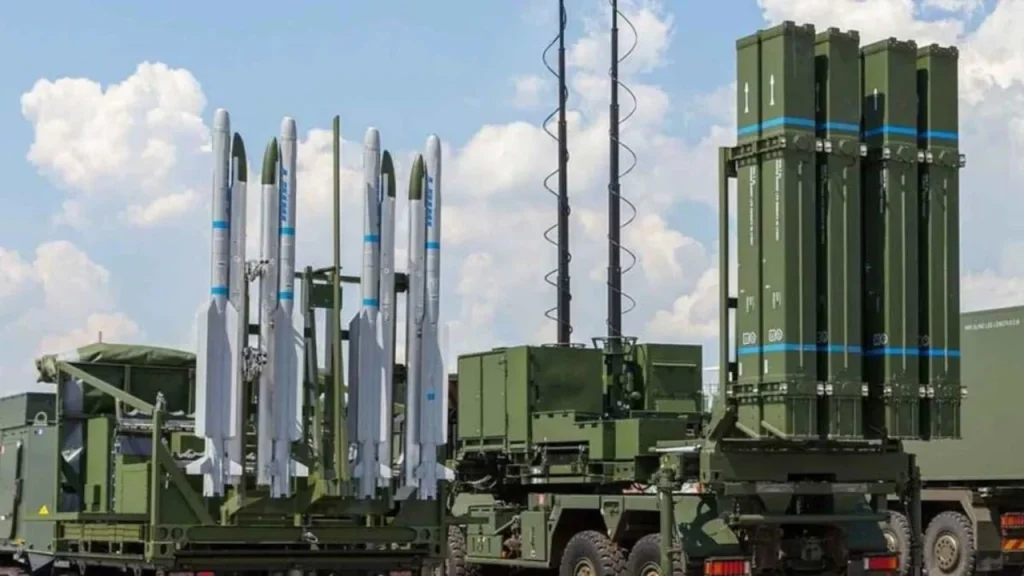In October 2022, Germany effectively persuaded approximately fifteen NATO members [or those on the verge of joining, such as Finland] to join its “European Sky Shield initiative” (ESSI). Special emphasis was placed on the IRIS-T SLM (manufactured by Diehl Defence), the Arrow-3 (developed by Israel with U.S. support), and the Patriot system. Germany possesses Patriot systems already.
Beginning in June 2022, the German parliament authorised the establishment of a 100 billion euro special fund to modernise the German armed forces. Along with other weapon systems, the funds are intended to finance IRIS-T SLM and Arrow 3 systems procurement within five years. The German defence budget reached a record 50.4 billion euros this year.
In Germany, the parliament must approve significant arms acquisitions. The German Bundestag’s budget committee also must authorise military projects with budgets exceeding 25 million euros.
Hence, the Bundestag Budget Committee, on June 15, approved funding for the acquisition of Israeli-American Arrow 3 missile defence systems and domestic IRIS-T SLM (Infra Red Imaging System Tail/Thrust Vector-Controlled Surface Launched Medium Range) air defence systems.
IRIS-T SLM
The Budget Committee has approved the procurement of six IRIS-T SLM system batteries (or firing units). The first battery will be delivered in 2024, and two more in 2025. The cost of acquisition is 950 million euros.
The unknown is the precise composition of the battery, but it usually consists of a mobile command and control unit, the TRML-4D radar, and several launch vehicles. The effectors are IRIS-T SL surface-to-air missiles launched from the ground. The missiles have a maximum range of 40 kilometres and can reach altitudes of 20 kilometres. The launch vehicles, command and control unit, and radar can be separated by tens or hundreds of kilometres.

The system underwent effective combat testing in Ukraine. A high level of automation is one of the principal advantages (and disadvantages) of IRIS-T SL and other Western air defence systems. This mechanisation is essential for addressing complex and multiple threats, such as simultaneous drone attacks, cruise missiles, and ballistic missiles.
Cruise missiles, particularly Russian ones, are currently considered the primary air-borne danger to European NATO nations; hence, the IRIS-T SLM is primarily used against these threats.
However, Russian drones are also maturing and undergoing combat testing. It will be intriguing to learn whether the system will be utilised against these less expensive Russian drones or whether Germany will require a new system.
Arrow 3
Israel has deployed the Arrow 3 anti-ballistic missile system since 2017. It is designed to intercept Theatre Ballistic Missiles (TBMs) ranging from 300 to 3,500 kilometres, including Medium-Range Ballistic Missiles (MRBMs). Arrow 3 can also eliminate Multiple Independently Targetable Reentry Vehicles (MIRVs) carried by Intercontinental Ballistic Missiles (ICBMs).
Arrow 3 intercepts its targets through direct impact outside the Earth’s atmosphere. The system is a streamlined variant of the American Ground-Based Interceptor (GBI) system. Unlike the GBI, Arrow 3 lacks the radar apparatus and space-based sensors required to distinguish between decoys and actual warheads on MIRVs.
Arrow 3 can be deployed against Russian hypersonic glide vehicles such as the Avangard, launched by UR-100N missiles, and mobile ICBMs such as the RS-24 Yars.

The Arrow 3 missiles are vertically launched from a trailer-mounted six-cell launcher. Two missiles are typically deployed against a single target. One launcher could theoretically neutralise three MIRVs carried by a Russian Yars missile. But it depends on the fire control system and the threat being addressed – if necessary; it will be necessary to “risk” one shot against one target.
Last year, Russian Defence Minister Sergey Shoygu disclosed in an Interfax report that 22 Avangard, Yars, and Sarmat ICBM carriers were in combat service. The Sarmat ICBM still needs to be operational, however. Consequently, Russia currently employs one regiment of Avangard (12 missiles in silos) and ten regiments of Yars ICBMs.
In addition to launchers and command and control assets, Germany will acquire sophisticated 900-kilometre-range EltaELM-2080/2080S Green Pine radar systems. However, the system will use data from the European radar network. Currently, Arrow 3 can receive information from Patriot radars. In time the German TRML-4D radars of the IRIS-T SLM systems would also be linked.
Following the American Integrated Air and Missile Defence Battle Command System (IBCS) model, Germany will likely seek to develop a network of interconnected sensors and effectors for air defence. Berlin may choose to acquire this innovative and potent American air defence command and control system unless it opts for a comparable European system.
The total investment by Germany in three Arrow 3 batteries will amount to four billion euros. The Bundestag has allocated 560 million euros for the procurement thus far. By 2025, the first German Arrow battery is anticipated to be operational.
